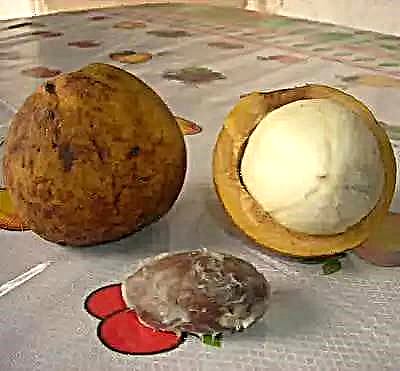Autumn came, and in the average Russian imperiously spoke the memory of their ancestors. She says: “Mammoth salts, otherwise there will be nothing to eat in winter!”
So they salted, fermented, boiled, dried and dried for lack of furry giants everything that only grows on Russian land and in neighboring countries.
What products do residents of the former USSR prefer? Yandex experts became interested in this issue, having analyzed more than 35 million requests for edible topics, which included the treasured “for the winter”. As a result, a list of the most popular winter harvesting products was compiled. We present the first ten to your attention.
10. Plums
 Few fruit can make such a wonderful jam - dense, velvety, delicious. You can make jam only from plums, but you can add apples, oranges, pears, nectarines and even juniper with tomatoes to it.
Few fruit can make such a wonderful jam - dense, velvety, delicious. You can make jam only from plums, but you can add apples, oranges, pears, nectarines and even juniper with tomatoes to it.
For plum lovers and sugar lovers, there are pickled plums with garlic or sour sauce from them, which is perfect for meat dishes. And plums are frequent “guests” in stewed fruit, usually mixed with cheaper aronia.
9. Cabbage
 Cabbage can be fermented both in a “natural” form, that is, only with salt, and with various flavors. The usual companions of sauerkraut for the winter are:
Cabbage can be fermented both in a “natural” form, that is, only with salt, and with various flavors. The usual companions of sauerkraut for the winter are:
- carrot;
- beet;
- apples
- cranberry;
- lingonberry;
- and even honey.
And then there is the so-called “crumble” - when not only white but also top, green leaves of cabbage are souring, which you can’t always buy in the store (there cabbage is usually already completely peeled). This dish is not used as an independent dish, but usually cabbage soup is cooked with it, which is called “gray” because of its color. And although this color is nondescript, in reality the “gray” cabbage soup is very tasty.
If you do not like the taste of sauerkraut, then you can marinate it solo or in the company of other vegetables (carrots, cabbage, garlic, etc.) or berries (cranberries or lingonberries). Or, in the "Georgian" version - with hot pepper. There is also a particularly vitamin version that grandmothers like to feed their grandchildren - cabbage mixed with sweet pepper, apples, onions and grapes.
8. Currant
 One of the advantages of currants (in addition to the prevalence, frost resistance and comparative unpretentiousness) is that it is beautifully gelled. Therefore, red currant jelly is one of the most popular dishes in all of Russia.
One of the advantages of currants (in addition to the prevalence, frost resistance and comparative unpretentiousness) is that it is beautifully gelled. Therefore, red currant jelly is one of the most popular dishes in all of Russia.
However, you can still make compotes from currants, cook jam, syrups (and then use them as the basis for fruit drinks), as well as simply wipe with sugar. The canned unsweetened version of this berry is excellent as a flavoring additive for fish or meat.
7. Carrots
 Most often, carrots do not act as an independent ingredient for harvesting, but complete with other vegetables (many of which have already been featured in the top 10 most popular harvesting products in Russia) - cabbage, beets, sweet peppers, zucchini and eggplant.
Most often, carrots do not act as an independent ingredient for harvesting, but complete with other vegetables (many of which have already been featured in the top 10 most popular harvesting products in Russia) - cabbage, beets, sweet peppers, zucchini and eggplant.
And it is usually used as a solo type of vegetable caviar - for example, in the seasoning "Poltava". Sometimes it is canned in oil or vinegar and served as a side dish for meat.
6. Apples
 Another fruit (besides plum), which managed to break into the list of the most popular, tasty and healthy preparations for the winter. And not in vain. By fertility and abundance, apples are akin to zucchini - they are also able to grow anywhere and anytime.
Another fruit (besides plum), which managed to break into the list of the most popular, tasty and healthy preparations for the winter. And not in vain. By fertility and abundance, apples are akin to zucchini - they are also able to grow anywhere and anytime.
And in the fall, something must be done with this fragrant abundance. That's what they do: they make jam, stewed fruit, distill apples to fragrant vinegar, cut the fruits and dry in the oven in the form of chips and even roll up jars filled with pies in advance so as not to mess around later. And apples are salted, fermented and soaked in kvass, rye malt or in honey water.
5. Eggplant
 In popularity, as an ingredient for winter preparations, the “little blue ones” are not much behind the zucchini. Perhaps due to the fact that these purple overseas guests are more capricious in cultivation.
In popularity, as an ingredient for winter preparations, the “little blue ones” are not much behind the zucchini. Perhaps due to the fact that these purple overseas guests are more capricious in cultivation.
The summer of 2019 turned out to be cold, which affected the ratings of many vegetable crops. Judging by the search queries, the citizens looked at the prices on the shelves, sighed and decided that the mammoth was a mammoth, but I wanted to eat right now.
As a result, the number of queries on the topic “How to cook eggplant for the winter” decreased by 15%; Currants and tender strawberries were also affected.
What is being done with eggplant? They are fermented on their own, fermented with cabbage (in stuffed form), marinated both simply in salt water with vinegar, and in a more refined mixture of olive oil, rice wine, soy sauce and rice vinegar. And for beauty sprinkle with sesame seeds.
Another very popular dish is stewed eggplant with vegetables, both cut into rings, and in the form of vegetable caviar.
4. bell pepper
 Like carrots, pepper rarely appears as an independent dish among the blanks. Usually he is a guest invited to tint the vegetable splendor of the workpiece. Except for lecho.
Like carrots, pepper rarely appears as an independent dish among the blanks. Usually he is a guest invited to tint the vegetable splendor of the workpiece. Except for lecho.
Surprisingly, the Bulgarian dish in its origin won the ardent love of Russians. If you use a search engine with the words "bell peppers for the winter", then the vast majority of recipes will be about him - about lecho. Although you can just pickle peppers or even make unsweetened confiture mixed with hot pepper - for meat and poultry dishes.
3. Zucchini
 Oh, these zucchini. They are ways to survive in the most unimaginable conditions and delight their owners with a plentiful harvest, grow to enormous size. However, joy quickly gives way to sorrow when tired owners load the tenth bucket into the car, and the squashes do not end there.
Oh, these zucchini. They are ways to survive in the most unimaginable conditions and delight their owners with a plentiful harvest, grow to enormous size. However, joy quickly gives way to sorrow when tired owners load the tenth bucket into the car, and the squashes do not end there.
So you have to throw all your strength into the fight against the harvest - fry, stew, cook and, of course, harvest for the winter.
Zucchini is usually marinated in a mixture of water, sugar, salt and vinegar. There are also more refined options when vegetables or even berries (gooseberries, currants) are added to zucchini. And if the zucchini is very young and did not have time to mature, they can be salted - yes, just like cucumbers, using the same technology.
But the main plus of zucchini is their ability to take on the taste of the surrounding products, acting as a kind of ideal recipient. So economical housewives rejoice, giving zucchini the taste of mushrooms, sweet pepper or even gooseberry with lemon in the form of jam.
2. Cucumbers
 Interestingly, it turns out that a person's place of residence can be determined by whether he twists tomatoes or cucumbers for the winter.
Interestingly, it turns out that a person's place of residence can be determined by whether he twists tomatoes or cucumbers for the winter.
- The closer the cuisine is to the Pacific Ocean, the higher the popularity of cucumber.
- Beyond the Yenisei, green and pimply vegetable reigns supreme in the harvesting.
- The only two renegade regions that violate the overall green picture in bright red are Khabarovsk and Primorsky Krai. Although there Signor Tomato overtakes his lanky vegetable counterpart to a minimum distance.
- True, there are dissidents in the European part of the country. For example, in Crimea, cucumbers are preferred - the only green island among the Red Sea. Maybe they are especially tasty among Crimeans.
Usually, for the winter, cucumbers are salted at full strength or to a “slightly salted” state. And they also make preparations for pickles from them - they grate the greens on a grater, mix with salt and garlic and roll them into jars.
1. Tomatoes
 The first place in the selection of the best products for harvesting for the winter went to a valuable source of vitamins and antioxidants. In addition, it is quite simple to cultivate and grows almost everywhere. What is being done to him? And why not do it!
The first place in the selection of the best products for harvesting for the winter went to a valuable source of vitamins and antioxidants. In addition, it is quite simple to cultivate and grows almost everywhere. What is being done to him? And why not do it!
Kvassyat: in a bucket put the leaves of horseradish, dill, currant or cherry, horseradish root, garlic (if there is a hotter desire, then a little cut hot pepper), pour brine. Then they wait about two weeks at room temperature and lay them out on the banks or just take them out to the winter balcony.
Subjected to heat treatment: used as a base for seasonings, usually adjika. There are a lot of recipes for adjika - each family has its own. Some people like it sharper and put more horseradish, others lean on hot pepper, while others like the "apple" option - when tomatoes are passed through a meat grinder with apples, carrots, sweet peppers and garlic.
If desired, you can add hot pepper. The resulting mixture is stewed in sunflower oil, brought to a boil and immediately poured into jars. Or they make Indian seasoning - chutney, when tomatoes are rolled into jars along with apples, onions, raisins and fresh ginger.
Marinate. There’s plenty of room for imagination - tomatoes can be pickled both separately and stuffed (cabbage, carrots, mushrooms). And you don’t even have to wait for the fruit to ripen - there are recipes for green tomatoes.
Salt: Tomatoes are poured with a salt solution mixed with sugar and dry mustard, rolled up in jars and patiently wait for the New Year, when the little red ones can be set on the table.
Drum: Recently, this method has become more and more popular with culinary, beginner and not very. Typically, dried tomatoes use cherry tomatoes, which are cut in half, sprinkled with a mixture of salt, pepper and herbs (usually marjoram) and put in the oven. When the vegetables are so well dried (the whole process takes from noon to day), they are poured with olive oil and sealed for the winter.
Enjoy your meal!












